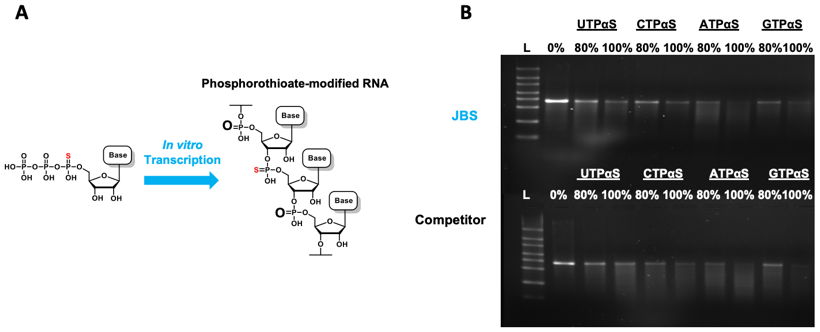Replacing a non-bridging oxygen in the phosphodiester linkage of RNA by sulfur results in phosphorothioate-modified RNA (Fig. 1A).
Such phosphorothioate-modified RNA is ideally suited as RT-PCR control e.g for diagnostic kits due to their improved stability profile[1]. Furthermore, phosphorothioate-modification of mRNA enhances translation efficiency when introduced into the region from the 5'‐end to the initiation codon and thus provides a new strategy to improve mRNA functionality in addition to established chemical modifications such as N1-Methylpseudouridine[2].
Preparation of phosphorothioate-modified (m)RNA is conveniently performed by T7 RNA polymerase-mediated incorporation of 5'-(α-thio) ribonucleotide triphosphates (NTPαS) such as CTPαS, ATPαS, UTPαS and GTPαS) (Fig. 1B).

Figure 1: Synthesis of phosphorothioate-modified RNA via in vitro transcription with NTPαS.
A) Phosphorothioate-modified RNA is characterized by substitution of a non-bridging oxygen in the phosphodiester linkage with sulfur.
B) Similar transcription efficiency of Jena Bioscience’s (JBS) and competitors NTPαS. In vitro transcription has been perfomed according to the HighYield T7 RNA Synthesis Kit protocol. Transcription efficiency was analyzed by agarose gelelectrophoresis (equal volumes of in vitro transcription reactions (5 µl of a 1:100 dilution), EtBr visualization of 1400 nt RNA transcript). L: Ladder, 0 %: only unmodified NTPs, 80 %: Substitution of unmodifed NTP by the corresponding NTPαS analog. 100 %: only NTPαS analog.

Please contact Barbara with all questions or inquiries you may have!
[1] Luo et al. (2021) High-quality RT-PCR with chemically modified RNA controls. Talanta 224 (2):850.
[2] Kawaguchi et al. (2020) Phosphorothioate Modification of mRNA Accelerates the Rate of Translation Initiation to Provide More Efficient Protein Synthesis. Angew. Chem. Int. Ed. 59 (40):17403.